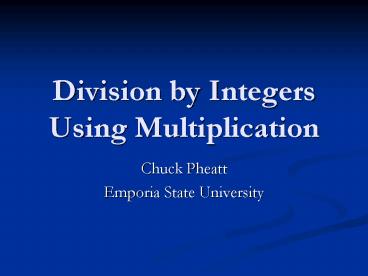Division by Integers Using Multiplication - PowerPoint PPT Presentation
1 / 10
Title:
Division by Integers Using Multiplication
Description:
Division by Invariant Integers using Multiplication. ... The Whole Thing. Activity 0. Activity 1. Activity 2. Activity 3. Activity 4. Questions? ... – PowerPoint PPT presentation
Number of Views:691
Avg rating:3.0/5.0
Title: Division by Integers Using Multiplication
1
Division by Integers Using Multiplication
- Chuck Pheatt
- Emporia State University
2
A More Precise Title
- Division by Invariant Integers using
Multiplication. - Reference Granlund, T. and Montgomery, P.L.
Proceedings of the ACM SIGPLAN '94 Conference on
Programming Language Design and Implementation
(PLDI), pages 61--72, Orlando, Florida, June 1994.
3
Unsigned Integer Division
- Suppose we want to perform an unsigned integer
division - Where
- 0 lt d lt 2N, d is the divisor and is invariant
- 0 n lt 2N, n is the dividend and is variable
- N is the word size
4
Unsigned Integer Division
- We would like to calculate 1/d using only
multiplications and shifts. We will use a
multiplier of the form - That is
5
The Unsigned Algorithm
- From Granlund and Montgomery, given a divisor d
and dividend n
6
So.
- Processors generally have very fast integer
multiply operations (59 cycles signed, 48
cycles unsigned). - The integer division instruction delivers only
one bit of quotient per cycle (2247 cycles
signed, 1741 cycles unsigned).
7
So.
- The cost for invariant integer division
(per quotient) - 1 multiply (4 cycles)
- 2 adds/subtracts (2 4 8 cycles)
- 2 shifts (2 4 8 cycles)
- 20 cycles total
8
The Activities
- A CS0 activity that introduces the idea of ones
and twos complement numeric representation and
using shift operations to replace multiplication
and division operations. - A CS1 activity that has students perform a
computer performance assessment utilizing the
generation of random values. - A CS2 activity that has students use inline
assembly language to improve computer algorithm
performance. - A systems programming (assembly language)
activity where students will use the approach to
optimize code. - A compiler writing course activity where students
develop a C/C program to create the code
necessary to implement the algorithm.
9
The Activities
- The Whole Thing
- Activity 0
- Activity 1
- Activity 2
- Activity 3
- Activity 4
10
- Questions?

